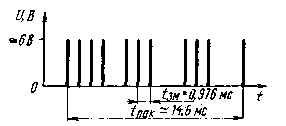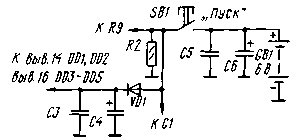
|
|
ENCYCLOPEDIA OF RADIO ELECTRONICS AND ELECTRICAL ENGINEERING Electronic password. Encyclopedia of radio electronics and electrical engineering
Encyclopedia of radio electronics and electrical engineering / Digital technology Modern security systems include, as a rule, a wearable keychain generator that emits a special signal code, and a special receiver that responds only to this signal code. We have already introduced our readers to such devices operating on infrared rays. But there was relatively little secrecy. The article below is devoted to the same topic. The IR key fob generator and its receiver have the same purpose, but the signal-code of the system is formed in accordance with the principle that uses the transmission time much more efficiently and thereby greatly increases its secrecy. IR transmitter Regardless of the nature of the radiation, whether it be a radio wave, ultrasound or light, special attention in automatic identification devices is paid to the signal itself. The probability of the appearance of exactly the same signal from an extraneous source should be negligible. The code message usually has the form of a binary sequence. For example, 1001101000111..., where one corresponds to the presence of radiation, and zero corresponds to a pause of "pure" ether or some other radiation. If the number of digits (familiarity) in such a signal is denoted by the Latin letter n, then placing ones and zeros in different ways, we can get 2 "different combinations of them. So with n \u7d 128 there can be 15, with n \u32768d 23 - 8388608, and with n=XNUMX - XNUMX. Among the many possible ones, one sequence is chosen as a code, or, in other words, an electronic password. A schematic diagram of a generator that generates a sequence of infrared flashes in this way is shown in fig. 1. Elements DD1.1, DD1.2, resistor R1 and quartz resonator ZQ1 form a master oscillator operating at a frequency of 32 Hz. Microcircuits DD768 and DD4, each of which is an eight-input multiplexer-demultiplexer, work as electronic switches. Their combined output (pins 5) is connected to one of the inputs X3-X0 - depending on the address received at the address inputs 7, 1, 2 (pins 4 and 11,10) and the signal at input S (pin 9) DD6 and DD4. Address and S-signal form the counter DD5. It is easy to calculate that the address change occurs here every 3 ms (0,976 / 25 s). This tsn is the duration of the familiarity in the code package. In the middle of each familiarity, a short (with a duration of about 10 μs, timp = R4C2) pulse can be generated at the output of the element DD1.4. But this will happen only if this familiarity corresponds to a signal 1 at the output of the switch. This pulse will open transistors VT1 and VT2 of the amplifier, and the current that has arisen in the IR diode B11 is converted into an IR flash of the same duration. The generation of the code sequence begins (when the power source is turned on and the button SB1 is pressed) with the formation of a short pulse at the input R of the counter DD3 (tr = R3C1), which sets it to zero, and ends with the appearance of 1 at output 29 (pin 14). Familiarity - there are 16 of them - follow in time in accordance with their numbering from 1 to 15 along the arrows of the inputs X1-X7 in the microcircuits DD4, DD5 -1,2, Z ... etc. (zero familiarity always corresponds to 1 - this is start pulse of the packet, not included in the number of code-forming ones). Thus, the total duration of the code message is 0,976-15 = 14,6 ms. The required code number is formed by switching the X-inputs of the DD4, DD5 microcircuits, i.e., by connecting the i-th arrow to the positive conductor of the power source, if the i-th bit of the code should be 1 (XO input of the DD4 microcircuit, which forms the starting pulse of the package , is already connected to the positive conductor) or to the negative one, if 0 is needed. 111011100111001 - with a common conductor of the power source. Since n=1,2,3,5,6,7, the number of different signals, any of which can be switched as code, is 10,11,12,15=4,8,9,13,14. The power source of the code generator is a 6-volt GB1 battery with a diameter of 10,3 and a length of 16 mm (standard size of foreign-made power sources, for example, GP11A, E11A batteries). The 2BLIK-1 lithium battery is also suitable, if the design provides for a compartment of the appropriate size for it. The dependence of the current consumed by the generator (Ipotr) and the current in the IR diode V11 (Iimp) on the voltage of the power source is shown in the table. Table 1
Generator parts are mounted on a printed circuit board (Fig. 2), made of double-sided foil fiberglass with a thickness of 1,2 ... 1,5 mm. The foil is not removed from the side of the parts - it is used as a common "grounded" conductor of the device circuits. In places where mounting conductors are passed or parts are brought out through holes in the board, circles with a diameter of 1,5 ... 2 mm are made in it (not shown in Fig. 2). The places of soldering to the foil of the leads of resistors, capacitors and other parts are indicated by black squares: the place where the printed wiring fragment is connected to it (by a wire jumper) is marked with a square with a light dot in the middle. To skip the leads of the oxide capacitor C4, a hole with a diameter of 2,5 mm was drilled in the board; the diameter of the protective circle etched in the foil here should be greater than -3...3.5 mm. The mounting plate is installed on the front clip glued from high-impact polystyrene. Its supports are three polystyrene columns 8,5 mm high glued to the panel with metal inserts-nuts pressed into them (M2 threads). The battery is installed in a special compartment to avoid the consequences of possible depressurization. Power switch SA1 (PD9-1) is located on the front panel. The SB1 button (PKN-159 or similar in size) must have a drive 6 ... 8 mm long - sufficient for its output through the hole in the front panel. The case in the form of an open box with dimensions of 88x37x16 mm, in which a fully assembled panel and a battery are installed, is glued from high-impact polystyrene 1,5 mm thick. A hole with a diameter of 5...6 mm was drilled in the case wall against the IR diode, which (to avoid debris) can be sealed with thin plastic. However, the wall may not be drilled - the power of the IR flashes of the generator is capable of "piercing" 1,5 ... 2 mm of polystyrene, but its "range" in this case will significantly decrease. Almost any IR diodes can be used in the code emitter, the restrictions are only overall: the height of the parts installed on the printed circuit board should not exceed 8 mm. All resistors - MLT-0,125. Capacitor C4 - oxide K50-16. Capacitor C6 (CE-DS Marcon) is mounted parallel to the board, its rated voltage must match the voltage of the power supply. Other capacitors - KM-5, KM-6, K10-17B. A properly assembled generator does not require adjustment. You can control its operation using an oscilloscope connected to the collector of the transistor VT1. After turning on the power and pressing the SB1 button on the oscilloscope screen (sweep waiting time - 20.. .30 ms), a sequence of pulses spaced in time in accordance with the switched code should appear and disappear. So, for example, the code 111011100111001 will correspond to the waveform shown in Fig. 3 ("extra" pulse at the beginning of the packet - start). By the amplitude of the pulses measured across the resistor R9, one can judge the current in the IR diode (Iimp (A) \u9d Uimp (V) / R20 (Ohm)), and in a fast sweep (50 ... 5 μs, also waiting) - about their shape and duration, which should be within 15 ... XNUMX µs.
The "two-stage" start of the code emitter - first by the SA1 switch, and then by the SB1 button, is associated with the peculiarity of self-excitation of quartz oscillators: slow entry into the operating mode due to the high quality factor of the quartz resonator.
The SA1 switch can be excluded, and the generator can be powered according to the circuit shown in fig. 5. But then the SB1 button will have to be pressed twice, since the first press may give the wrong combination. It can be dispensed with even if the power source is a low-voltage battery or a lithium cell, which can provide the generator with long-term operation when the microcircuits are constantly on. For example, a lithium cell with a voltage of 3 V and an electric capacity of 0,1 Ah will work for about a year. In the case of powering the generator according to the scheme shown in fig. 4, it is necessary to control the leakage current of the capacitor C6 - it must be significantly less than Ipotr indicated in the table. By increasing the resistance of the resistor R7, which limits the current in the IR diode, the capacitance of this capacitor can be reduced - the large "range" of the IR emitter (with R9 \u3,9d 10 Ohm, exceeding XNUMXm) may simply be unnecessary. Author: Yu. Vinogradov, Moscow; Publication: N. Bolshakov, rf.atnn.ru
Artificial leather for touch emulation
15.04.2024 Petgugu Global cat litter
15.04.2024 The attractiveness of caring men
14.04.2024
▪ Revealed the secret of non-freezing water on Mars ▪ Single housing digital UV sensor ▪ Genes are responsible for addiction to coffee ▪ Prototype mobile digital TV from MICROSOFT and LINX ELECTRONICS ▪ HyperX Specter computer glasses
▪ section of the site Biographies of great scientists. Article selection ▪ article Without further ado. Popular expression ▪ article What famous namesakes died while on the exploding ships? Detailed answer ▪ article Work on cardboard cutting machines. Standard instruction on labor protection ▪ article Power supply. Directory
Home page | Library | Articles | Website map | Site Reviews www.diagram.com.ua |






 Arabic
Arabic Bengali
Bengali Chinese
Chinese English
English French
French German
German Hebrew
Hebrew Hindi
Hindi Italian
Italian Japanese
Japanese Korean
Korean Malay
Malay Polish
Polish Portuguese
Portuguese Spanish
Spanish Turkish
Turkish Ukrainian
Ukrainian Vietnamese
Vietnamese



 Leave your comment on this article:
Leave your comment on this article: